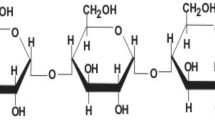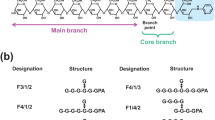Abstract
Alpha-cyclodextrin (α-CD) glycosyltransferase (α-CGTase) can convert starch into α-CD blended with various proportions of β-cyclodextrin (β-CD) and/or γ-cyclodextrin (γ-CD). In this study, we verified the catalytic characteristics of purified Y195I α-CGTase and elucidated the mechanism of action with molecular dynamic (MD) simulations. We found that purified Y195I α-CGTase produced less α-CD, slightly more β-CD, and significantly more γ-CD than wild-type α-CGTase. Correspondingly, α-CD-based K m values increased, and β-CD- and γ-CD-based K m values decreased. MD simulation studies revealed that the dynamic trajectories of the substrate oligosaccharide chain in the mutant CGTase binding site were significantly different from those in the wild-type enzyme, with reduced hydrophobic interaction, finally resulting in different product specificity and more γ-CD formation.







Similar content being viewed by others
References
Knegtel RM, Strokopytov B, Penninga D, Faber OG, Rozeboom HJ, Kalk KH, Dijkhuizen L, Dijkstra BW (1995) Crystallographic studies of the interaction of cyclodextrin glycosyltransferase from Bacillus circulans strain 251 with natural substrates and products. J Biol Chem 270(49):29256–29264
Knegtel RM, Wind RD, Rozeboom HJ, Kalk KH, Buitelaar RM, Dijkhuizen L, Dijkstra BW (1996) Crystal structure at 2.3 A resolution and revised nucleotide sequence of the thermostable cyclodextrin glycosyltransferase from Thermonanaerobacterium thermosulfurigenes EM1. J Mol Biol 256(3):611–622
Leemhuis H, Dijkstra BW, Dijkhuizen L (2002) Mutations converting cyclodextrin glycosyltransferase from a transglycosylase into a starch hydrolase. FEBS Lett 514(2–3):189–192
Strokopytov B, Penninga D, Rozeboom HJ, Kalk KH, Dijkhuizen L, Dijkstra BW (1995) X-ray structure of cyclodextrin glycosyltransferase complexed with acarbose. Implications for the catalytic mechanism of glycosidases. Biochemistry 34(7):2234–2240
Uitdehaag JC, Mosi R, Kalk KH, van der Veen BA, Dijkhuizen L, Withers SG, Dijkstra BW (1999) X-ray structures along the reaction pathway of cyclodextrin glycosyltransferase elucidate catalysis in the alpha-amylase family. Nat Struct Biol 6(5):432–436. doi:10.1038/8235
Klein C, Schulz GE (1991) Structure of cyclodextrin glycosyltransferase refined at 2.0 A resolution. J Mol Biol 217(4):737–750
Strokopytov B, Knegtel RM, Penninga D, Rozeboom HJ, Kalk KH, Dijkhuizen L, Dijkstra BW (1996) Structure of cyclodextrin glycosyltransferase complexed with a maltononaose inhibitor at 2.6 angstrom resolution. Implications for product specificity. Biochemistry 35(13):4241–4249. doi:10.1021/bi952339h
Penninga D, Strokopytov B, Rozeboom HJ, Lawson CL, Dijkstra BW, Bergsma J, Dijkhuizen L (1995) Site-directed mutations in tyrosine 195 of cyclodextrin glycosyltransferase from Bacillus circulans strain 251 affect activity and product specificity. Biochemistry 34(10):3368–3376
Parsiegla G, Schmidt AK, Schulz GE (1998) Substrate binding to a cyclodextrin glycosyltransferase and mutations increasing the gamma-cyclodextrin production. Eur J Biochem / FEBS 255(3):710–717
Wind RD, Uitdehaag JC, Buitelaar RM, Dijkstra BW, Dijkhuizen L (1998) Engineering of cyclodextrin product specificity and pH optima of the thermostable cyclodextrin glycosyltransferase from Thermoanaerobacterium thermosulfurigenes EM1. J Biol Chem 273(10):5771–5779
van der Veen BA, Uitdehaag JC, Dijkstra BW, Dijkhuizen L (2000) The role of arginine 47 in the cyclization and coupling reactions of cyclodextrin glycosyltransferase from Bacillus circulans strain 251 implications for product inhibition and product specificity. Eur J Biochem / FEBS 267(12):3432–3441
van der Veen BA, Uitdehaag JC, Penninga D, van Alebeek GJ, Smith LM, Dijkstra BW, Dijkhuizen L (2000) Rational design of cyclodextrin glycosyltransferase from Bacillus circulans strain 251 to increase alpha-cyclodextrin production. J Mol Biol 296(4):1027–1038. doi:10.1006/jmbi.2000.3528
Li Z, Wang M, Wang F, Gu Z, Du G, Wu J, Chen J (2007) gamma-Cyclodextrin: a review on enzymatic production and applications. Appl Microbiol Biotechnol 77(2):245–255. doi:10.1007/s00253-007-1166-7
Nakamura A, Haga K, Yamane K (1994) Four aromatic residues in the active center of cyclodextrin glucanotransferase from alkalophilic Bacillus sp. 1011: effects of replacements on substrate binding and cyclization characteristics. Biochemistry 33(33):9929–9936
Xie T, Song B, Yue Y, Chao Y, Qian S (2014) Site-saturation mutagenesis of central tyrosine 195 leading to diverse product specificities of an alpha-cyclodextrin glycosyltransferase from Paenibacillus sp. 602–1. J Biotechnol 170:10–16. doi:10.1016/j.jbiotec.2013.10.032
Sali A, Blundell TL (1993) Comparative protein modelling by satisfaction of spatial restraints. J Mol Biol 234(3):779–815. doi:10.1006/jmbi.1993.1626
Eswar N, Eramian D, Webb B, Shen MY, Sali A (2008) Protein structure modeling with MODELLER. Methods Mol Biol 426:145–159. doi:10.1007/978-1-60327-058-8_8
Eswar N, Webb B, Marti-Renom MA, Madhusudhan MS, Eramian D, Shen MY, Pieper U, Sali A (2007) Comparative protein structure modeling using MODELLER. In: Baxevanis AD, Petsko GA, Stein LD, Stormo GD (eds) Current protocols in protein science. Chapter 2:Unit 2 9. Wiley, New York. doi:10.1002/0471140864.ps0209s50
Humphrey W, Dalke A, Schulten K (1996) VMD: visual molecular dynamics. J Mol Graph 14(1):33–38, 27–38
Ponder JW, Case DA (2003) Force fields for protein simulations. Adv Protein Chem 66:27–85
Kirschner KN, Yongye AB, Tschampel SM, Gonzalez-Outeirino J, Daniels CR, Foley BL, Woods RJ (2008) GLYCAM06: a generalizable biomolecular force field. Carbohydrates. J Comput Chem 29(4):622–655. doi:10.1002/jcc.20820
Case DA, Cheatham TE 3rd, Darden T, Gohlke H, Luo R, Merz KM Jr, Onufriev A, Simmerling C, Wang B, Woods RJ (2005) The Amber biomolecular simulation programs. J Comput Chem 26(16):1668–1688. doi:10.1002/jcc.20290
White RP, Meirovitch H (2004) Lower and upper bounds for the absolute free energy by the hypothetical scanning Monte Carlo method: application to liquid argon and water. J Chem Phys 121(22):10889–10904. doi:10.1063/1.1814355
Petersen HG (1995) Accuracy and efficiency of the particle mesh Ewald method. J Chem Phys 103(9):3668–3679
Cornell WD, Cieplak P, Bayly CI, Gould IR, Merz KM, Ferguson DM, Spellmeyer DC, Fox T, Caldwell JW, Kollman PA (1995) A second generation force field for the simulation of proteins, nucleic acids, and organic molecules. J Am Chem Soc 117(19):5179–5197
Hubbard SJ, Thornton JM (1993) Naccess version 2.1.1. Department of Biochemistry and Molecular Biology, University College, London
Bakan A, Meireles LM, Bahar I (2011) ProDy: protein dynamics inferred from theory and experiments. Bioinformatics 27(11):1575–1577. doi:10.1093/bioinformatics/btr168
Xue Z, Chao Y, Wang D, Wang M, Qian S (2011) Overexpression of a recombinant amidase in a complex auto-inducing culture: purification, biochemical characterization, and regio- and stereoselectivity. J Ind Microbiol Biotechnol 38(12):1931–1938. doi:10.1007/s10295-011-0979-7
Bradford MM (1976) A rapid and sensitive method for the quantitation of microgram quantities of protein utilizing the principle of protein-dye binding. Anal Biochem 72:248–254
Nakamura N, Horikoshi K (1976) Characterization and some cultural conditions of a cyclodextrin glycosyltransferase-producing alkalophilic Bacillus sp. Agric Biol Chem 40(4):753–757
Laemmli UK (1970) Cleavage of structural proteins during the assembly of the head of bacteriophage T4. Nature 227(5259):680–685
Uitdehaag JC, Kalk KH, van Der Veen BA, Dijkhuizen L, Dijkstra BW (1999) The cyclization mechanism of cyclodextrin glycosyltransferase (CGTase) as revealed by a gamma-cyclodextrin-CGTase complex at 1.8-A resolution. J Biol Chem 274(49):34868–34876
Qi Q, Zimmermann W (2005) Cyclodextrin glucanotransferase: from gene to applications. Appl Microbiol Biotechnol 66(5):475–485. doi:10.1007/s00253-004-1781-5
Kelly RM, Dijkhuizen L, Leemhuis H (2009) The evolution of cyclodextrin glucanotransferase product specificity. Appl Microbiol Biotechnol 84(1):119–133. doi:10.1007/s00253-009-1988-6
Leemhuis H, Kelly RM, Dijkhuizen L (2010) Engineering of cyclodextrin glucanotransferases and the impact for biotechnological applications. Appl Microbiol Biotechnol 85(4):823–835. doi:10.1007/s00253-009-2221-3
Tachibana Y, Takaha T, Fujiwara S, Takagi M, Imanaka T (2000) Acceptor specificity of 4-alpha-glucanotransferase from Pyrococcus kodakaraensis KOD1, and synthesis of cycloamylose. J Biosci Bioeng 90(4):406–409
Kumar V (2010) Analysis of the key active subsites of glycoside hydrolase 13 family members. Carbohydr Res 345(7):893–898. doi:10.1016/j.carres.2010.02.007
Uitdehaag JC, van der Veen BA, Dijkhuizen L, Elber R, Dijkstra BW (2001) Enzymatic circularization of a malto-octaose linear chain studied by stochastic reaction path calculations on cyclodextrin glycosyltransferase. Proteins 43(3):327–335
Acknowledgments
This work was supported by the Ministry of Science and Technology of China (Grant No. 2012AA020301), the Natural Science Foundation of China (Grant No. 31171643) and the State Key Laboratory of Natural and Biomimetic Drugs. The computational work was carried out at National Supercomputer Center in Tianjin, and the calculations were performed on TianHe-1(A).
Conflict of interest
The authors declare no conflict of interest.
Author information
Authors and Affiliations
Corresponding authors
Additional information
Fangjin Chen and Ting Xie contributed equally to this work.
Electronic supplementary material
Below is the link to the electronic supplementary material.
ESM 1
(DOCX 1.73 mb)
Rights and permissions
About this article
Cite this article
Chen, F., Xie, T., Yue, Y. et al. Molecular dynamic analysis of mutant Y195I α-cyclodextrin glycosyltransferase with switched product specificity from α-cyclodextrin to γ-cyclodextrin. J Mol Model 21, 208 (2015). https://doi.org/10.1007/s00894-015-2734-x
Received:
Accepted:
Published:
DOI: https://doi.org/10.1007/s00894-015-2734-x




